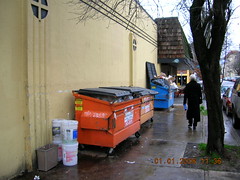
Photo by Dan Anderson |
On Wednesday, City Council will consider (this is on regular agenda – not time certain, so probably sometime between 10:30 and noon) a plan to phase out storage of dumpsters on sidewalks (technically not allowed today, but not enforced). Here’s the full report (PDF, 186K).
14 responses to “Reclaiming the Sidewalk”
This looks good, and I do sometimes wonder if someone/thing is hiding in/behind a dumpster that I’m walking by; the only thing I wonder though (just skimmed through the 12-pg. PDF) is where the 1.5 FTE would come from, i.e., new positions created, or are they pulling some employees away from another essential function?
They should start with the cars that constantly park on the sidewalk instead. I can’t take a walk without having to deal with some inconsiderate person who’s got two wheels on the sidewalk killing the plant strip or just totally blocking the sidewalk. Sometimes they just block the hole thign.These people make cars drive faster and make it hard for pedestrians espcially blind people. Small businesses have a legitimite use for those dumpsters.. what’s legitimate about illegally parking on the sidewalk?
I think they should leave the dumpsters! It makes Portland look more like Manhattan that way. Now if they could just use the MAX to haul away all the garbage at night like they do the subways in NYC… :)
Slick, if someone is parking on or across the sidewalk during business hours, be sure to call the Parking Enforcement Hotline (503-823-5195). I’ve had great response from them.
Unfortunately, we have a herd of jerks in our neighborhood who always, always block the sidewalk when they’re home…which is exactly not during business hours. There seems to be nothing we can do about them.
Hmmm, a way to pay for new sidewalks…a $200 fine for blocking a sidewalk at any time of day or night. Something for the Willamette Pedestrian Coalition to champion.
Is it illegal during non-business hours to block sidewalks, but not enforced? Sorta like bikes coasting thru stop signs used to be?
With the dumpsters removed, sidewalks no longer need to be super-sized at 12 feet wide and can be retained at a more modest normal size of six to eight feet wide.
I also like the concept Greg Tompkins suggested hauling garbage away by rail. Max however, on its own right-of-ways does not run all that close to the dumpsters and the source of the garbage, but the streetcars do. Therefore the streetcars would be a better choice to haul the garbage, even if they have to pull trailers behind them for capacity. Additionally, instead of fleecing taxpayers for snail rail and poaching parking meter revenues from motorists for trolly operations, both Max and the streetcar lines could be used for freight thereby making them more financially self-sustainable
This HURTS businesses like my own that are in non-flexible 100 year old buildings with maxed out interior space and 16 foot sidewalks. They should continue with the current law making it impossible to build like this in the future, but the grandfather clause must be maintained.
NJD,
They don’t have the problem in Salem! The blocks are huge, the sidewalks are wide and there are alleys. I don’t know who the brain was that designed Portland. They must have envisioned it being a small town forever…
Actually, if I remember correctly, they were trying to maximize the number of corner lots. Thus, the closely spaced streets and small blocks.
Aaron:
My recollection of Portland city history was that there wasn’t much city planning when it came to the street layouts, that developers got parcels of land and could lay out the streets in the manner which they deemed fit, which is why you get areas like Ladd’s Addition or streets that don’t quite match up (which happens here and there). As such, the “maximize the number of corner lots” theory makes a lot of sense, I’m sure that’s what most developers preferred.
I don’t know who the brain was that designed Portland.
Then may I humbly suggest you read up on the history of Portland before posting more of your many gripes and rants here. Thanks.
– Bob R.
“Now if they could just use the MAX to haul away all the garbage at night like they do the subways in NYC…”
I’m pretty certain that these trains are hauling the garbage collected within the subway system itself, not from the businesses and homes up on street level.
I’m pretty certain that these trains are hauling the garbage collected within the subway system itself, not from the businesses and homes up on street level.
Yes, the garbage train is primarily used to clean the trackway of litter and carry away trash from the station bins.
Somewhere between this 1993 New York Times article on the garbage train and this 2003 New York Times piece on the newer system, the train was upgraded to a French-built system which vacuums the trackway directly, reducing but not eliminating the need for work crews to manually bag litter found between the rails.
Excerpts:
It’s interesting that NYC’s system is so extensive that they spend $15 million just on a garbage removal system, about the cost of 4 to 5 complete single-car MAX trains or a couple dozen buses. Of course, depending on how much it reduces the size of required work crews, it could easily save New York that much money every few years.
– Bob R.
Although our rail system is too limited to serve any sort of garbage cleanup, why not brainstorm some ideas for utilizing our rail during the off-hours.